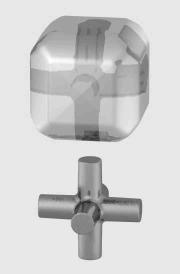
Photo from wikipedia
Parallel robots with rigid transmission mechanisms have been widely developed to improve the speed, precision, and load capability. However, it is still challenging in promoting soft parallel robots due to… Click to show full abstract
Parallel robots with rigid transmission mechanisms have been widely developed to improve the speed, precision, and load capability. However, it is still challenging in promoting soft parallel robots due to the difficulty in accurate kinematic modeling of soft continuum links. In this article, we present a general framework on the design, kinematic modeling, model-based characterization, and control for a class of soft parallel robots. The designed soft parallel robot consists of three fiber-reinforced soft pneumatic actuators, a base stage, and an output stage. With the introduction of the mathematical toolkit of the absolute nodal coordinate formulation, we develop a continuum-based model to describe and parameterize both the global complex configuration and the local large deformation of the soft parallel robot. In this sense, the mappings among the defined kinematic spaces of the robot can be characterized through force analysis. Based on the developed model, we next analyze the robot’s workspace and stiffness with different design parameters, which are also verified by a set of experiments. Finally, we establish a model-based trajectory tracking controller for the soft parallel robot. The experimental results demonstrate that with the feedforward controller, the end effector of the soft parallel robot can well follow the desired trajectories under different output velocities, where the average positioning error is about 2.6–3.9% of the maximum length of the workspace.
Journal Title: IEEE Transactions on Robotics
Year Published: 2022
Link to full text (if available)
Share on Social Media: Sign Up to like & get
recommendations!